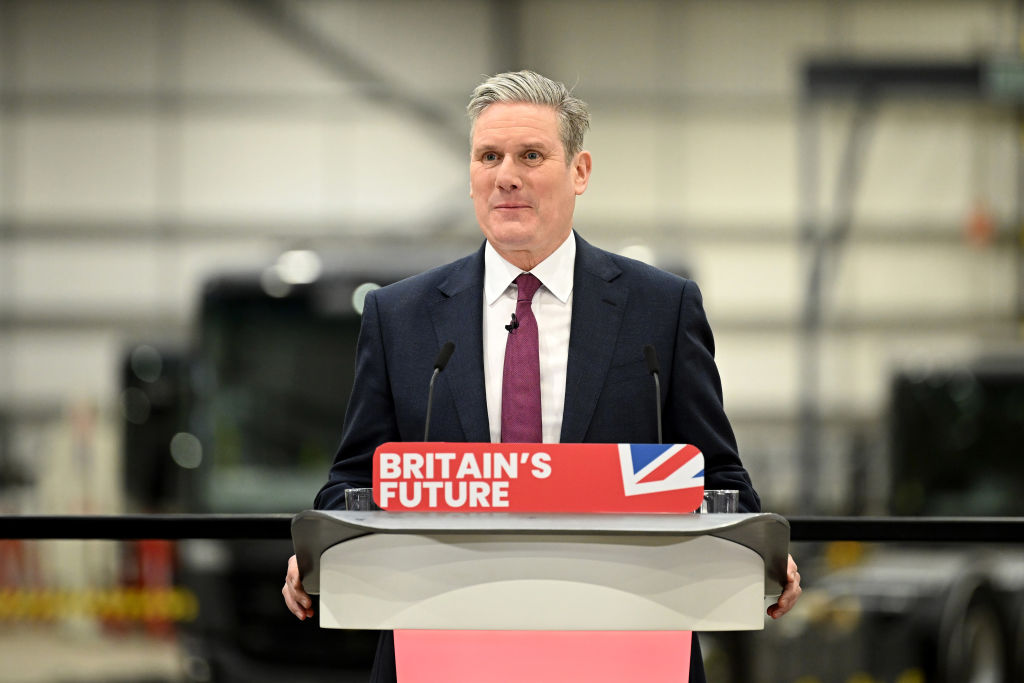Merry Christmas Keir Starmer. The Labour leader ends the year with a commanding lead in the polls and both business and media figures working on the assumption that by this time next year he will be in 10 Downing Street. In contrast, Rishi Sunak has little reason for cheer this December (even if he did tell The Spectator that despite everything he is enjoying the job). There is one area where the Tories still think they have an advantage over Labour and that’s Starmer’s green spending plan. ‘It’s how we will will the election,’ insists one optimistic government aide.
Announced by Rachel Reeves in 2021 at Labour conference, the party pledged to borrow £28bn a year to invest in green jobs and industry. Back then, Reeves promised to be ‘the first green chancellor’ as she unveiled the party’s biggest spending pledge to date. The policy has parallels with Joe Biden’s Green New Deal — with Labour planning to attract a matching sum of private investment in green technologies. However, as well as being one of the party’s most expensive policies, it is also the most divisive. Now there’s a debate about whether it will survive an election.
Today’s Guardian reports that the party is considering scaling back the policy amid fears the Conservatives will use it as a central line of attack in the general election campaign. As the Prime Minister hinted to me in an interview for the Christmas issue, the Tories will argue the £28bn will inevitably lead to tax rises. Starmer and Reeves are due to discuss the flagship economic policy next month.
As well as being one of the party’s most expensive policies, it is also the most divisive.
Since 2021, the cost of borrowing has sharply risen (the idea of ‘low for long’ is long gone) and while Labour have tried to blame this squarely on Liz Truss and her mini-budget, it still means they have a lot less room for manoeuvre if in power. Given Reeves sees Labour’s path back to power as resting on fiscal responsibility, she has already had to scale back the policy once — in June she said that rather than start the green fund at £28bn in the first year of a Labour government, they would ‘ramp up’ by the middle of the first parliament. Now Reeves says it will only be achieved if it fits with Labour’s fiscal rule to have national debt growing at a slower rate than the economy. This isn’t forecast to happen until 2027, such is the dismal outlook for growth.
So, will Starmer and Reeves now go further? The process for deciding policy for the manifesto is well underway with a February deadline. As I revealed this month, the plan is for a slimmed down document with talk of a mission-led government and few if any expensive pledges. Shadow minister Jonathan Ashworth is in charge of efforts to make sure the party’s policies are ‘bulletproof’ from Tory attacks. The problem for the party is that while the green spending policy appears to be far from ‘bulletproof’, it also forms the party’s clean energy mission and is a key part of Labour’s growth strategy. This mission involves accelerating decarbonising the power grid by five years to 2030 — a policy Starmer personally committed to.
It means opinion is divided on how to proceed. Ed Miliband is credited with being the brainchild of the policy (for all the talk earlier this year of Miliband’s demise, he survived the reshuffle and remains on good terms with Keir Starmer). There are also party figures who say changing it drastically could leave the party without a serious growth plan when they have already made ambitious pledges to ‘go for growth’. What’s more, shadow treasury figures see the policy as one business likes.
‘As a general rule, if you work on the campaign you are less pro it,’ says a party figure of the debate. It is these party figures who tend to be the most nervous as they wait for the Tory attack machine to turn on in an election year. It is an area the Tories are comfortable fighting on and one they would focus on in the election campaign. As one shadow cabinet source puts it to The Spectator: ‘It’s a subject of much discussion. We’ve got to a place where the focus is all on the price and not what it would achieve.’ It means that changes to how it is packaged seem very likely, including a push to argue the scheme would lower household bills.
Were Starmer to try to drop the £28bn figure, he would likely run into internal party trouble quickly — the price tag covers the mission. Were he to drop the mission over worries about Tory attacks, it would be used by the Tories to — you guessed it — attack him and argue he is a flip-flopper. But more than that, the policy has existed for so long now that to make substantial changes to it in an election year would raise questions about the credibility of Labour’s plans for government and whether they are ready for the level of scrutiny about to hit them.







Comments